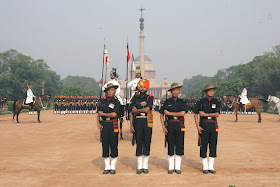
Saturday, April 18, 2009
M-MRCA UPDATE (April, 2009)

Thursday, April 9, 2009
FLAVOURS OF BENGAL
My demands have always been modest. I never ask for those long-eared horses of Bankura, or intricately woven kantha shawls from Santiniketan if anyone ever comes visiting from Bengal. I, however, do often ask friends or family members, coming to Delhi from Calcutta to make a small detour to Krishnanagar. For that’s where you get the best sarbhaja and sarpuria, two sweets that I swear by. You get them elsewhere, of course — but you just can’t beat the sweets of Krishnanagar.I visit krishnanagar almost every time i visit balurghat- as it comes in the way.I love the lunch in krishnagar- i remember nodir-macher jhol ,crispy allo bhaaja, begun bhaaja ,mosur dal ar aatop chaler bhat.yummy!
Actually, it is quite interesting how districts and towns outside Calcutta are widely known for a special dish or two. If Krishnanagar is famous for its sweets cooked with the cream of milk, a school of thoug
But what’s pelob?. I knew piyaj (onion) and posto, but pelob was a word that I was yet to encounter. It’s a word that’s locally used to denote something that’s been lovingly done . From Burdwan, you can get a dish of aar fish, cooked with wax gourd, and from Midnapur, a dish of koi fish cooked in a leaf. The jheengey chingri of South 24 Parganas consists of small shrimps and ridged gourd cooked in mustard oil with turmeric, onion, garlic, ginger, chillies and chopped tomatoes — and finally tempered with a pinch of garam masala and chopped coriander.Hooghly offers chingrir bahar — a dish of shredded raw jackfruit and shrimps — and Midnapur is represented by its mourolar tok, small mourala fish in a sweet and tart gravy.
The menu has some delicacies — including a chitol dhoka of Coochbehar. The chitol is a much loved fish, the top part is full of bones and the stomach smooth as a baby’s cheeks. Get some medium sized pompfret and cook it with posto. The ensuing dish — postomakha roopchanda — is a popular Bankura dish. Of course, it’s another matter that the pomfret is a sea fish and can’t be a part of the indigenous Bankura cuisine. But the fish is now easily available everywhere, and Bengalis have developed a taste for it.But clearly the posto figures prominently in most parts of Bengal. And there are of course all kinds of ways of cooking it — as fried balls, ground raw with mustard oil and chillies, with shrimps and meat — and a variety of vegetables from bottle gourd to potatoes.
Some would say that these are dishes that are available in all parts of Bengal. But then a cuisine is finally the sum total of all that the districts have to offer. It’s time we doffed our caps to them.













